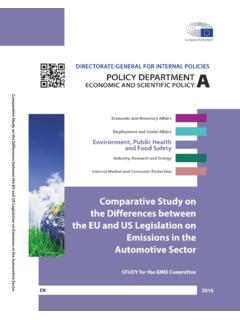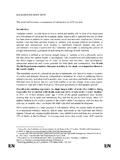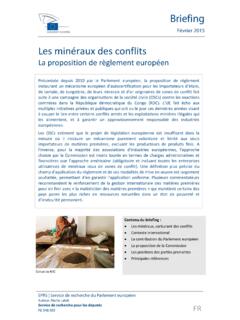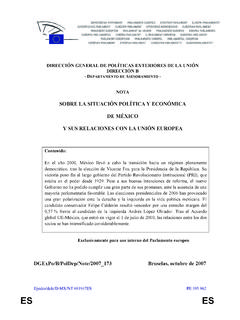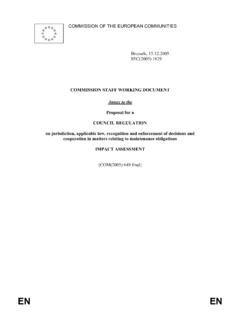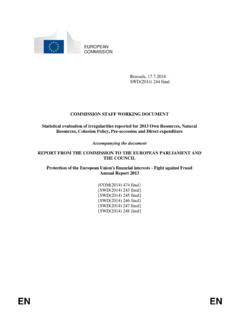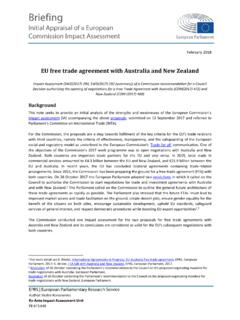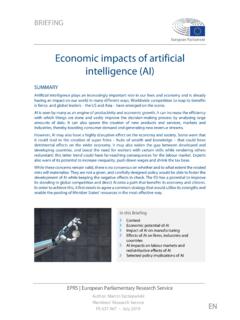Transcription of EU guidelines on ethics in artificial intelligence ...
1 BRIEFING. EU guidelines on ethics in artificial intelligence : Context and implementation SUMMARY. The discussion around artificial intelligence (AI) technologies and their impact on society is increasingly focused on the question of whether AI should be regulated. Following the call from the European Parliament to update and complement the existing Union legal framework with guiding ethical principles, the EU has carved out a 'human-centric' approach to AI that is respectful of European values and principles. As part of this approach, the EU published its guidelines on ethics in AI in April 2019, and European Commission President-elect, Ursula von der Leyen, has announced that the Commission will soon put forward further legislative proposals for a coordinated European approach to the human and ethical implications of AI. Against this background, this paper aims to shed some light on the ethical rules that are now recommended when designing, developing, deploying, implementing or using AI products and services in the EU.
2 Moreover, it identifies some implementation challenges and presents possible further EU action ranging from soft law guidance to standardisation to legislation in the field of ethics and AI. There are calls for clarifying the EU guidelines , fostering the adoption of ethical standards and adopting legally binding instruments to, inter alia, set common rules on transparency and common requirements for fundamental rights impact assessments, and to provide an adequate legal framework for face recognition technology. Finally, the paper gives an overview of the main ethical frameworks for AI under development outside the EU ( in the United States and China). In this Briefing EU human-centric approach to artificial intelligence Key ethical requirements Implementation challenges Possible further EU action International context Outlook EPRS | European Parliamentary Research Service Author: Tambiama Madiega Members' Research Service PE September 2019 EN.
3 EPRS | European Parliamentary Research Service EU human-centric approach to artificial intelligence Background artificial intelligence (AI) commonly refers to a combination of: machine learning techniques used for searching and analysing large volumes of data; robotics dealing with the conception, design, manufacture and operation of programmable machines; and algorithms and automated decision- making systems (ADMS) able to predict human and machine behaviour and to make autonomous decisions. 1 AI technologies can be extremely beneficial from an economic and social point of view and are already being used in areas such as healthcare (for instance, to find effective treatments for cancer) and transport (for instance, to predict traffic conditions and guide autonomous vehicles), or to efficiently manage energy and water consumption. AI increasingly affects our daily lives, and its potential range of application is so broad that it is sometimes referred to as the fourth industrial revolution.
4 2. However, while most studies concur that AI brings many A recent report by benefits, they also highlight a number of ethical, legal and Algorithmwatch a not-for-profit economic concerns, relating primarily to the risks facing organisation promoting more human rights and fundamental freedoms. For instance, AI poses transparency in the use of risks to the right to personal data protection and privacy, and algorithms lists examples of equally so a risk of discrimination when algorithms are used for ADMS already in use in the EU. AI. purposes such as to profile people or to resolve situations in applications are wide-ranging. criminal justice. 3 There are also some concerns about the impact For instance, the Slovenian Ministry of Finance uses a of AI technologies and robotics on the labour market ( jobs machine-learning system to being destroyed by automation). Furthermore, there are calls to detect tax evasion and tax fraud. assess the impact of algorithms and automated decision- In Belgium, the police are using a making systems (ADMS) in the context of defective products predictive algorithm to predict (safety and liability), digital currency (blockchain), car robberies.
5 In Poland, this disinformation-spreading (fake news) and the potential military technology is used to profile application of algorithms (autonomous weapons systems and unemployed people and decide cybersecurity). Finally, the question of how to develop ethical upon the type of assistance principles in algorithms and AI design has also been raised. 4 appropriate for them. EU approach Policy-makers across the world are looking at ways to tackle the risks associated with the development of AI. That said, the EU can be considered a front-runner with regard to establishing a framework on ethical rules for AI. Leading the EU-level debate, the European Parliament called on the European Commission to assess the impact of AI, and made wide-ranging recommendations on civil law rules on robotics in January 2017. The Parliament drew up a code of ethics for robotics engineers and asked the Commission to consider the creation of a European agency for robotics and AI, tasked with providing the technical, ethical and regulatory expertise needed in an AI-driven environment.
6 5. Against this background, in 2018 the Commission adopted a communication to promote the development of AI in Europe, and in 2019 it published a coordinated plan on AI endorsed by the Council of the European Union to coordinate the EU Member States' national AI strategies. 6. Building on this groundwork, in April 2019 the Commission published a set of non-binding ethics guidelines for trustworthy AI. Prepared by the Commission's High-Level Expert Group on AI, composed of 52 independent experts, this document aims to offer guidance on how to foster and secure the development of ethical AI systems in the EU. 2. EU guidelines on ethics in artificial intelligence : Context and implementation Notion of human-centric AI. The core principle of the EU guidelines is that the EU must develop a 'human-centric' approach to AI that is respectful of European values and principles. The human-centric approach to AI strives to ensure that human values are central to the way in which AI systems are developed, deployed, used and monitored, by ensuring respect for fundamental rights, including those set out in the Treaties of the European Union and Charter of Fundamental Rights of the European Union, all of which are united by reference to a common foundation rooted in respect for human dignity, in which the human being enjoys a unique and inalienable moral status.
7 This also entails consideration of the natural environment and of other living beings that are part of the human ecosystem, as well as a sustainable approach enabling the flourishing of future generations to come. 7. While this approach will unfold in the context of the global race on AI, EU policy-makers have adopted a frame of analysis to differentiate the EU strategy on AI from the US strategy (developed mostly through private-sector initiatives and self-regulation) and the Chinese strategy (essentially government-led and characterised by strong coordination of private and public investment into AI. technologies). 8 In its approach, the EU seeks to remain faithful to its cultural preferences and its higher standard of protection against the social risks posed by AI in particular those affecting privacy, data protection and discrimination rules unlike other more lax jurisdictions. 9. To that end, the EU ethics guidelines promote a trustworthy AI system that is lawful (complying with all applicable laws and regulations), ethical (ensuring adherence to ethical principles and values) and robust (both from a technical and social perspective) in order to avoid causing unintentional harm.
8 Furthermore, the guidelines highlight that AI software and hardware systems need to be human-centric, developed, deployed and used in adherence to the key ethical requirements outlined below. Key ethical requirements The guidelines are addressed to all AI stakeholders designing, developing, deploying, implementing, using or being affected by AI in the EU, including companies, researchers, public services, government agencies, institutions, civil society organisations, individuals, workers and consumers. Stakeholders can voluntarily opt to use these guidelines and follow the seven key requirements (see box on the right) when they are developing, deploying or using AI systems in the EU. Human agency and oversight Respect for human autonomy and fundamental rights is at the heart of the seven EU ethical rules. The EU guidelines prescribe The key EU requirements for three measures to ensure this requirement is reflected in practice: achieving trustworthy AI.
9 To make sure that an AI system does not hamper EU human agency and fundamental rights, a fundamental rights impact oversight assessment should be undertaken prior to its robustness and safety development. Mechanisms should be put in place privacy and data afterwards to allow for external feedback on any potential governance infringement of fundamental rights; transparency human agency should be ensured, users should be diversity, non- able to understand and interact with AI systems to a discrimination and fairness satisfactory degree. The right of end users not to be societal and environmental subject to a decision based solely on automated well-being processing (when this produces a legal effect on users or accountability significantly affects them) should be enforced in the EU;. 3. EPRS | European Parliamentary Research Service a machine cannot be in full control. Therefore, there should always be human oversight. Humans should always have the possibility ultimately to over-ride a decision made by a system.
10 When designing an AI product or service, AI developers should consider the type of technical measures that should be implemented to ensure human oversight. For instance, they should provide a stop button or a procedure to abort an operation to ensure human control. Different types of fundamental rights impact assessments are already being used in the EU. The European Commission adopted a set of guidelines on fundamental rights in impact assessments and uses this checklist to identify which fundamental rights could be affected by a proposal and to assess systematically the impact of each envisaged policy option on these rights. The General Data Protection Regulation (GDPR). provides for a regulatory framework that obliges data controllers to apply a Data Protection Impact Assessment (DPIA). The Government of Canada has also developed an Algorithmic Impact Assessment that assesses the potential impact of an algorithm on citizens, with a digital questionnaire evaluating the potential risk of a public-facing automated decision system.
